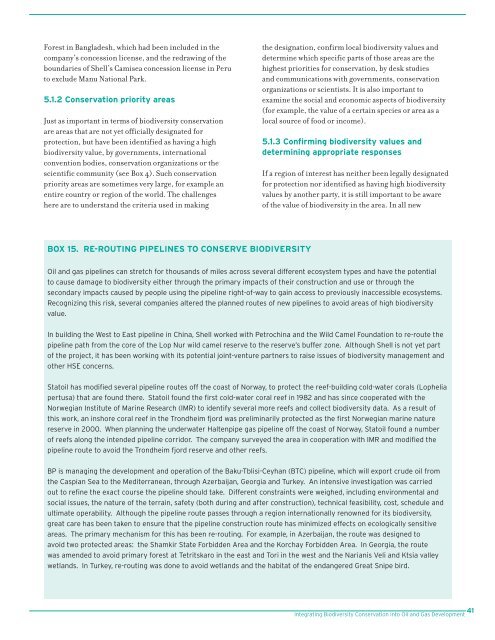Integrating Biodiversity Conservation into Oil and Gas ... - EBI
Integrating Biodiversity Conservation into Oil and Gas ... - EBI
Integrating Biodiversity Conservation into Oil and Gas ... - EBI
You also want an ePaper? Increase the reach of your titles
YUMPU automatically turns print PDFs into web optimized ePapers that Google loves.
Forest in Bangladesh, which had been included in the<br />
company’s concession license, <strong>and</strong> the redrawing of the<br />
boundaries of Shell’s Camisea concession license in Peru<br />
to exclude Manu National Park.<br />
5.1.2 <strong>Conservation</strong> priority areas<br />
Just as important in terms of biodiversity conservation<br />
are areas that are not yet officially designated for<br />
protection, but have been identified as having a high<br />
biodiversity value, by governments, international<br />
convention bodies, conservation organizations or the<br />
scientific community (see Box 4). Such conservation<br />
priority areas are sometimes very large, for example an<br />
entire country or region of the world. The challenges<br />
here are to underst<strong>and</strong> the criteria used in making<br />
the designation, confirm local biodiversity values <strong>and</strong><br />
determine which specific parts of those areas are the<br />
highest priorities for conservation, by desk studies<br />
<strong>and</strong> communications with governments, conservation<br />
organizations or scientists. It is also important to<br />
examine the social <strong>and</strong> economic aspects of biodiversity<br />
(for example, the value of a certain species or area as a<br />
local source of food or income).<br />
5.1.3 Confirming biodiversity values <strong>and</strong><br />
determining appropriate responses<br />
If a region of interest has neither been legally designated<br />
for protection nor identified as having high biodiversity<br />
values by another party, it is still important to be aware<br />
of the value of biodiversity in the area. In all new<br />
BOX 15. RE-ROUTING PIPELINES TO CONSERVE BIODIVERSITY<br />
<strong>Oil</strong> <strong>and</strong> gas pipelines can stretch for thous<strong>and</strong>s of miles across several different ecosystem types <strong>and</strong> have the potential<br />
to cause damage to biodiversity either through the primary impacts of their construction <strong>and</strong> use or through the<br />
secondary impacts caused by people using the pipeline right-of-way to gain access to previously inaccessible ecosystems.<br />
Recognizing this risk, several companies altered the planned routes of new pipelines to avoid areas of high biodiversity<br />
value.<br />
In building the West to East pipeline in China, Shell worked with Petrochina <strong>and</strong> the Wild Camel Foundation to re-route the<br />
pipeline path from the core of the Lop Nur wild camel reserve to the reserve’s buffer zone. Although Shell is not yet part<br />
of the project, it has been working with its potential joint-venture partners to raise issues of biodiversity management <strong>and</strong><br />
other HSE concerns.<br />
Statoil has modified several pipeline routes off the coast of Norway, to protect the reef-building cold-water corals (Lophelia<br />
pertusa) that are found there. Statoil found the first cold-water coral reef in 1982 <strong>and</strong> has since cooperated with the<br />
Norwegian Institute of Marine Research (IMR) to identify several more reefs <strong>and</strong> collect biodiversity data. As a result of<br />
this work, an inshore coral reef in the Trondheim fjord was preliminarily protected as the first Norwegian marine nature<br />
reserve in 2000. When planning the underwater Haltenpipe gas pipeline off the coast of Norway, Statoil found a number<br />
of reefs along the intended pipeline corridor. The company surveyed the area in cooperation with IMR <strong>and</strong> modified the<br />
pipeline route to avoid the Trondheim fjord reserve <strong>and</strong> other reefs.<br />
BP is managing the development <strong>and</strong> operation of the Baku-Tblisi-Ceyhan (BTC) pipeline, which will export crude oil from<br />
the Caspian Sea to the Mediterranean, through Azerbaijan, Georgia <strong>and</strong> Turkey. An intensive investigation was carried<br />
out to refine the exact course the pipeline should take. Different constraints were weighed, including environmental <strong>and</strong><br />
social issues, the nature of the terrain, safety (both during <strong>and</strong> after construction), technical feasibility, cost, schedule <strong>and</strong><br />
ultimate operability. Although the pipeline route passes through a region internationally renowned for its biodiversity,<br />
great care has been taken to ensure that the pipeline construction route has minimized effects on ecologically sensitive<br />
areas. The primary mechanism for this has been re-routing. For example, in Azerbaijan, the route was designed to<br />
avoid two protected areas: the Shamkir State Forbidden Area <strong>and</strong> the Korchay Forbidden Area. In Georgia, the route<br />
was amended to avoid primary forest at Tetritskaro in the east <strong>and</strong> Tori in the west <strong>and</strong> the Narianis Veli <strong>and</strong> Ktsia valley<br />
wetl<strong>and</strong>s. In Turkey, re-routing was done to avoid wetl<strong>and</strong>s <strong>and</strong> the habitat of the endangered Great Snipe bird.<br />
41<br />
<strong>Integrating</strong> <strong>Biodiversity</strong> <strong>Conservation</strong> <strong>into</strong> <strong>Oil</strong> <strong>and</strong> <strong>Gas</strong> Development
















![[PDF] Community Development Toolkit - CommDev](https://img.yumpu.com/48616495/1/184x260/pdf-community-development-toolkit-commdev.jpg?quality=85)
